Abstract
In this paper, a robust optimized controller is implemented in the photovoltaic generator system (PVGS). The PVGS is composed of individual photovoltaic (PV) cells, which convert solar energy to electrical energy. To optimize the efficiency of the PVGS under variable solar irradiance and temperatures, a maximum power point tracking (MPPT) controller is necessary. Additionally, the PVGS output voltage is typically low for many applications. To achieve the MPPT and to gain the output voltage, an increasing boost converter (IBC) is employed. Then, two issues should be considered in MPPT. At first, a smooth control signal for adjusting the duty cycle of the IBC is important. Another critical issue is the PVGS and IBC unknown sections, i.e., the total system uncertainty. Therefore, to address the system uncertainties and to regulate the smooth duty cycle of the converter, a robust dynamic sliding mode control (DSMC) is proposed. In DSMC, a low-pass integrator is placed before the system to suppress chattering and to produce a smooth actuator signal. However, this integrator increases the system states, and hence, a sliding mode observer (SMO) is proposed to estimate this additional state. The stability of the proposed control scheme is demonstrated using the Lyapunov theory. Finally, to demonstrate the effectiveness of the proposed method and provide a reliable comparison, conventional sliding mode control (CSMC) with the same proposed SMO is also implemented.
Keywords:
photovoltaic generator system (PVGS); dynamic sliding mode control (DSMC); sliding mode observer (SMO); maximum power point tracking (MPPT); increasing boost converter (IBC) MSC:
93C10
1. Introduction
The increase in the use of fossil fuels leads to global warming. This has driven significant adoption of wind turbines [1,2] or solar energy [3,4], because they are accessible, renewable, and clean [5]. In particular, solar energy has gained attention due to the cost-effectiveness of PVGS worldwide [6]. However, the output power of PVGS depends on solar irradiation and ambient temperature [7], which are not constant, i.e., are variable and fluctuate over time [6,7]. To improve and enhance the PVGS efficiency, it is essential to use an MPPT controller [8,9].
Typically, MPPT is achieved through the duty cycle adjusting of power converter following the PVGS [4,8], often using an IBC. Various MPPT controllers have been proposed in the literature [9], such as linear [10,11] or nonlinear approaches [12,13,14,15,16,17,18,19,20].
For example, in [10], the settling time and overshoot are reduced through a PID controller. Another linear strategy is based on LQR [11] for IBC. But linear controllers are not suitable for MPPT [9]. The P&O method is known as a nonlinear procedure, which can oscillate near the maximum power [12,13] or can remain in a local maximum [12,13]. In [13], a combination of adaptive PID and P&O was used. The PID is used to improve the performance of P&O.
Another nonlinear approach including PSO [14], model predictive controller [15], neural networks [16], Chaotic Horse Herd Optimizer [17], fuzzy controllers [18], ANFIS, and fuzzy sliding mode controller [19,20]. Note that all these intelligent approaches might not be very representative, as they suffer from computational cost. Among all of them, just sliding mode control is invariant [20].
Due to the available uncertainties of the total system in PVGS and IBC, a robust approach such as SMC is essential to regulate the duty cycle of the converter. SMC is known for the invariant as its important property, which is stronger than the robustness [21,22,23]. Hence, SMC is used in many MPPT controllers [24,25,26,27,28,29,30]. However, many SMC-based MPPT controllers suffer from chattering due to the use of the Signum function [20,21,22], which prevents a smooth duty cycle.
To eliminate chattering, several methods have been proposed [31], such as BL-SMC [32], ABL-SMC [33,34,35], HOSMC [36,37,38], and DSMC [39,40,41]. However, the first two BL-SMC and ABL-SMC lose the invariance property [31,32]. Because in these methods, the system states are provided into the defined layer. HOSMC uses an observer to estimate the higher-order derivatives of the system model [42,43,44].
In the last approach, i.e., DSMC, the discontinuous Signum function effect is mitigated by a low-pass integrator filter before the system, increasing the system states that need to be estimated by an observer [39,40,41]. Thus, in DSMC, the increased state should be estimated, while in HOSMC, the system model differentiation must be estimated, making DSMC preferable.
The concepts like model identifications [45,46], parameter identifications [47,48], and disturbance observers [49] are used in controlling systems (linear or nonlinear), utilizing system outputs as feedback. Additionally, SMO is invariant, similar to SMC. Therefore, SMO maintains invariance against disturbance or uncertainty [50,51].
Motivated by the critical issue of chattering, the DSMC has been proposed in this paper to have MPPT of PVGS and preserve invariance to address model uncertainty, and also reliably prevent chattering. Then, a new SMO is constructed to implement this controller and to identify the system model. The Lyapunov theory is then implemented to prove the stabilization of the DSMC and SMO.
Therefore, the overall contribution of this paper can be summarized as follows:
- A new MPPT approach is implemented for PVGS.
- A new structure of robust DSMC is proposed.
- The chattering is removed using DSMC.
- A smooth input control is obtained for the duty cycle of IBC.
- A new scheme of SMO is proposed to estimate the unknown uncertain of the total system (PVGS and IBC).
The proposed approach is detailed in six sections. Section 2 presents the photovoltaic model structure. Section 3 explains the MPPT model and linear state feedback. Section 4 discusses the proposed SMO and DSMC. Finally, Section 5 and Section 6 provide simulation results and conclusions, respectively.
Moreover, Table 1 shows all the acronyms that are used in this paper.

Table 1.
Nomenclature.
2. Photovoltaic Model Structure
The PVGS has two inputs: as the solar irradiation and as the cell temperature. Then, the complete series system, which includes the PVGS and the DC-DC IBC, is illustrated in Figure 1 [4,27].

Figure 1.
The overall structure of PVGS and IBC.
In this figure, and are PVGS current and voltage outputs, and are the fixed current and voltage outputs of the IBC, and is the duty cycle of the IBC (the output of PWM).
2.1. PVGS Model
The output current of a single PV cell, depicted in Figure 2, is given by the following equation [8,9,10,11,12,13,14,15,16,17,18,19,23,24,25,26,27,28,29,30].
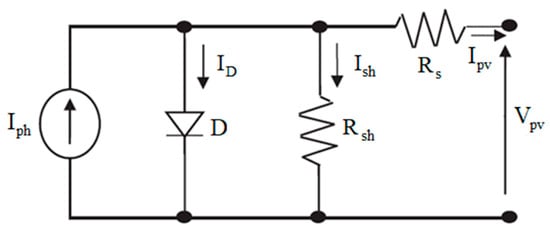
Figure 2.
A single PV cell.
Using as the electron charge and as the Boltzmann constant, the thermal voltage is defined as . Moreover, is cell reverse saturation current, is reference temperature, and are the short-circuit current and temperature coefficient in the short-circuit case, both at reference condition, and and are the output current and voltage of the PV. Using and as the numbers of parallel and series arrays of PV cells in a PVGS, the relationship between its output current, i.e., and its output voltage, i.e., , is as follows:
such that , , , , and .
2.2. IBC Model
Figure 3 shows an IBC, which is described by the following equations, where is the inductor current.

Figure 3.
The IBC structure.
In which, and are input capacitor and self-inductor, respectively, is the output capacitor, and is the semiconductor switch. The dynamic of is ignored because it is supposed the output voltage and output current are constant. In addition, duty cycle is defined in Figure 1.
3. MPPT Structure
The MPPT of PVGS is achieved if the derivative of output power with respect to voltage is zero. Then, the state variable is defined as follows and should be zero:
Now we have
and also
or
in which
By definition of , we get
Therefore
where is an unknown variable considered as uncertainty due to the unknown variable .
Next, we calculate the variables , , and . First, we define the function :
Then, we have
Thus, one can write
Now, considering the equation:
Therefore
Finally
Then
Now, we applied the following state feedback to Equation (13), with a new input variable .
We have
Now, we define the state variables , and therefore
4. Observer and Controller Design
The parameters and are chosen such that matrix is Hurwitz and pair is controllable. Then, for any matrix , there exists matrix that satisfies the following Lyapunov equation [20]:
Such that both matrixes and are symmetric and SPD.
4.1. Proposed SMO
To achieve MPPT, the state variables and in Equation (24) should be zero. To implement DSMC, the unavailable variable should be estimated. To this end, the following SMO with error estimation and auxiliary signal is proposed.
Remark 1.
Considering a bound for uncertain has no problem. It is very popular considering such a bound, because after proofing the closed-loop stability, all the variables of the systems are bounded (see Section 7 of [20]).
Theorem 1.
The error estimation converges to zero in the above proposed SMO.
Proof.
The derivative of the error estimation can be obtained as follows using Equations (24) and (26):
Using the Lyapunov function as
Then, due to the symmetric of matrix , we have
Thus, one can obtain
or
Leading to
Using as the minimum eigenvalue and referring to the following inequalities
Consequently
Then, the error dynamic and axillary signal converge to zero. □
4.2. Proposed DSMC
To address uncertainty and achieve a smooth duty cycle, DSMC is proposed and designed. Moreover, CSMC is also designed for comparison with DSMC using the same SMO in both approaches in order to carry out a fair comparison. According to the observer Equation (26), the following equations can be concluded:
Then, in DSMC, the sliding variable is defined as
Theorem 2.
The equation of sliding surface (36) reaches zero in finite time using the following input.
Proof.
Equation (36) leads to
Using Equations (37) and (38) results in
Suppose as the Lyapunov function
Then is the finite reaching time to the sliding surface [21]. □
4.3. CSMC Design
In CSMC, the sliding variable is defined as
Theorem 3.
The equation of sliding surface (41) reaches zero in finite time using the following input.
Proof.
Equation (41) leads to
Using Equations (42) and (43) results in
Suppose as the Lyapunov function.
Then is the finite reaching time to the sliding surface [21]. □
5. Presentation of Simulation Results
The single solar panel PV cells parameters are listed in Table 2, which are extracted from TE500CR [52].

Table 2.
Single PV cell parameters.
The IBC parameters are also denoted in Table 3 [4].

Table 3.
The converter parameters.
Additionally, we have chosen , , also and , i.e., all the initial values of the observer are set to zero. Moreover, we have selected , , and and chose and . For a reliable comparison, two simulations are conducted using DSMC and CSMC, both based on the same SMO.
To show the performance of the approaches and according to Figure 4 and Figure 5, the solar irradiation and the temperature increase from to and from to at times and , respectively.
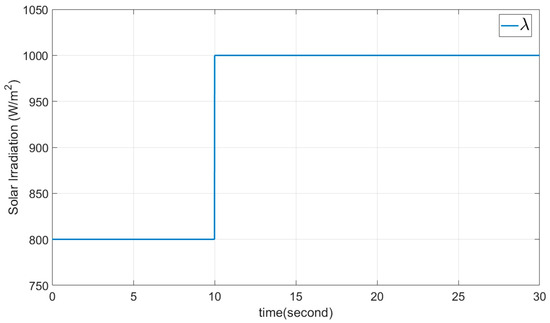
Figure 4.
PV irradiation variations.
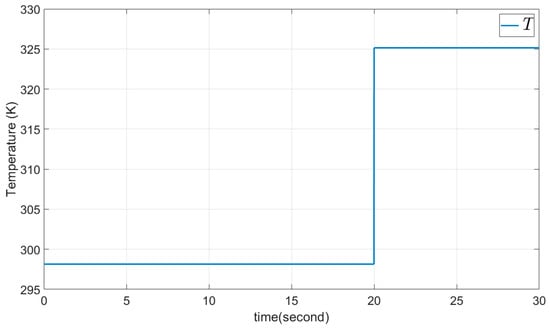
Figure 5.
PV temperature variations.
5.1. Example 1: The DSMC Proposed Method
The block diagram of the proposed DSMC is shown in Figure 6. Therefore, after the definition of state variables, a state feedback with a new input variable is implemented. After that, to estimate the added extra state, an SMO is used. Then, the derivative of this new input control is calculated. Finally, the integrator will remove the chattering, which is produced by the Signum function. Note that the sampling time is and the PWM frequency is 10,000.
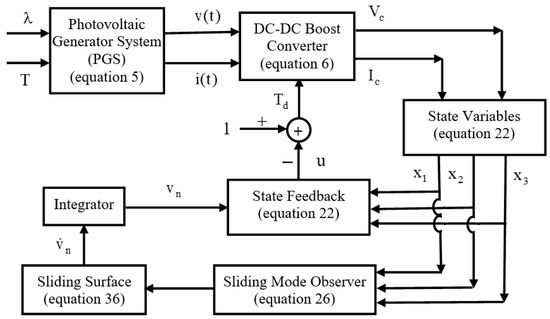
Figure 6.
The diagram of the proposed DSMC.
The parameters , , are selected as sliding surface coefficients, and we chose and . The initial value is selected as to calculate the input control from Equation (37). The results are presented in Figure 7, Figure 8, Figure 9, Figure 10 and Figure 11, all of them without chattering. Figure 7 shows the output power derivative with respect to voltage and its estimation, which are zero. It deviates from zero only when the solar irradiation and temperature are varying. Figure 8 shows the output current, which increases with rising solar irradiation and temperature, consistent with Equations (4) and (5). Figure 9 shows the output voltage, and Figure 10 presents the smooth duty cycle of the IBC (the output of PWM). The duty cycle also decreases to maintain the converter output voltage fixed at , when the output voltage of PVGS increases. Figure 11 shows the sliding surface and its finite-time convergence to zero.
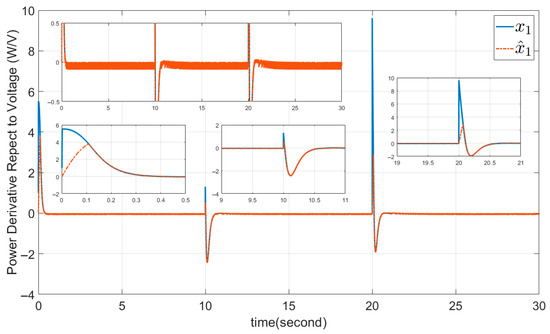
Figure 7.
PVGS output power derivative and its estimation in DSMC.
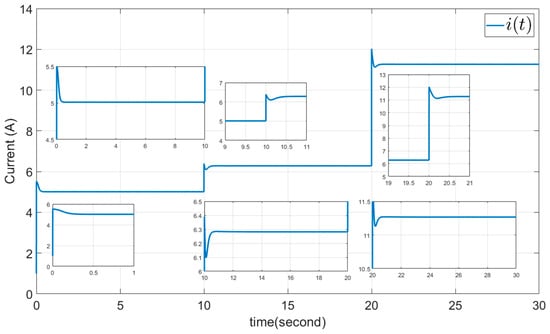
Figure 8.
PVGS output current in DSMC.
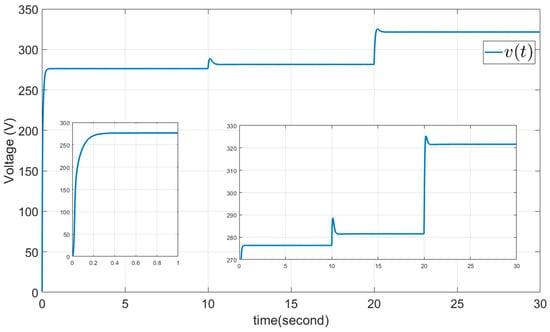
Figure 9.
PVGS output voltage in DSMC.
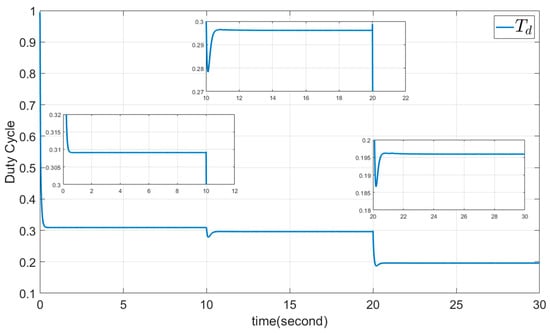
Figure 10.
Duty cycle of IBC in DSMC.
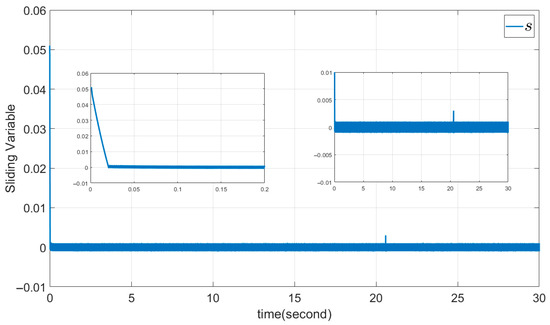
Figure 11.
Sliding variable in DSMC.
5.2. Example 2: The CSMC Approach
Here CSMC is used with the same parameters as the DSMC example. Hence, the coefficients of sliding surface (39) are set as , , and also and . The results are shown in Figure 12, Figure 13, Figure 14, Figure 15 and Figure 16.
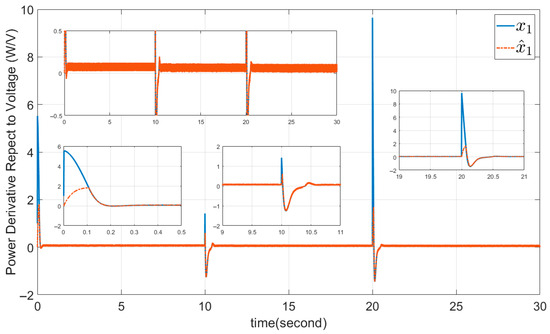
Figure 12.
PVGS output power derivative and its estimation in CSMC.

Figure 13.
PVGS output current in CSMC.
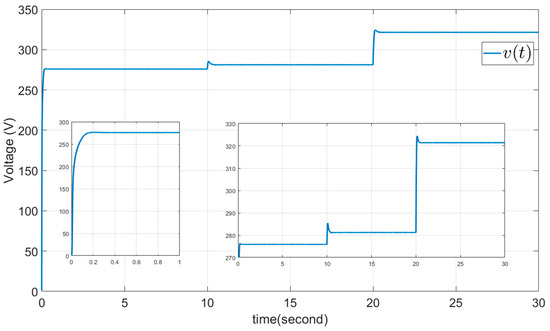
Figure 14.
PVGS output voltage in CSMC.
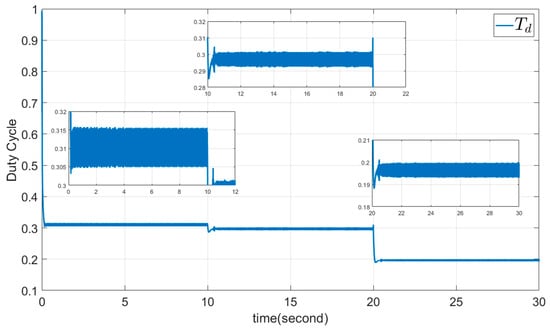
Figure 15.
Duty cycle of IBC in CSMC.
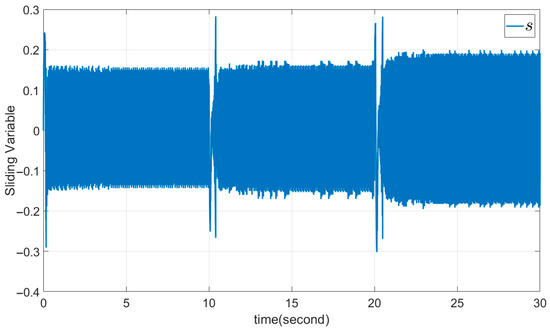
Figure 16.
Sliding variable in CSMC.
Figure 12 shows the output power derivative with respect to voltage and its estimation, which are zero, deviating only when solar irradiation and temperature are varying. Figure 13 shows the output current, which also increases with rising solar irradiation and temperature, and is consistent with Equations (4) and (5). This is rational according to Equations (4) and (5). Figure 14 shows the output voltage, and Figure 15 also presents the duty cycle of the converter (the output of PWM). The duty cycle also decreases to maintain the converter output voltage fixed at , when the output voltage of PVGS increases. Figure 16 shows the sliding surface and its finite-time convergence to zero. The noticeable chattering can be seen in Figure 15 and Figure 16.
5.3. Comparison Results: The DSMC and CSMC Approach
Figure 7 is similar to Figure 12; however, Figure 7 shows better efficiency in MPPT. Since the output power derivative with respect to voltage is completely zero in Figure 7, but it deviates from zero in Figure 12. The low amplitude in the observer in these figures is due to the Signum function in SMO. Furthermore, the duty cycle in Figure 10 is smooth, while in Figure 15, it exhibits high-frequency chattering, making it unsuitable for the IBC and cannot be applied to it.
Figure 17 shows the output powers. As one can see, the output power of the two approaches is same in amplitude, except that in DSMC, chattering is removed, but in CSMC, it is still available.
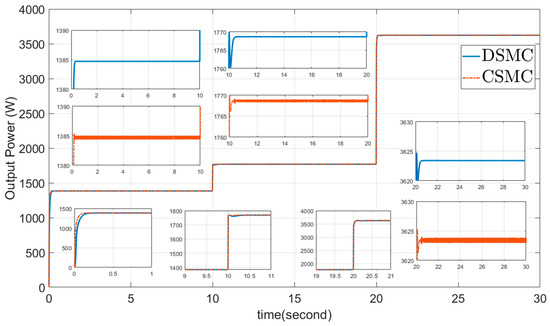
Figure 17.
The output power of DSMC and CSMC.
Moreover, Table 4 compares some statistical parameters of DSMC and CMC, such as minimum (Min), maximum (Max), and RMS of all variables. As we can see, there are not many differences in most of these parameters, especially in the important variable duty cycle of . Anyway, the parameters of the sliding surface in DSMC are much smaller than CSMC, i.e., the invariance property of DSMC is better.

Table 4.
Some statistical parameters.
Comparing these figures highlights the superior performance of the proposed DSMC and SMO. From a controller design perspective, DSMC outperforms CSMC in chattering suppression. Additionally, the simple design of DSMC compared to CSMC is evident.
6. Conclusions
This paper introduces a new method to regulate the smooth duty cycle of an increasing boost converter (IBC), which is positioned after a photovoltaic generator system (PVGS). By appropriately selecting the converter duty cycle, the maximum power point tracking (MPPT) of the PVGS can be achieved. Initially, a state feedback is used to linearize the system. However, the combined model of PVGS and IBC has some uncertainties. To address these uncertainties and ensure a smooth duty cycle, dynamic sliding mode control (DSMC), as a new robust chattering-free controller, is proposed. Also, a new structure for the sliding mode observer (SMO) is developed to implement the DSMC. The performance of this approach is compared with conventional sliding mode control (CSMC) using similar parameters with the same SMO. The comparison reveals that CSMC exhibits high-frequency chattering, while DSMC eliminates it. Additionally, DSMC is noted for its simplicity in concept and implementation. The closed-loop stability is ensured using Lyapunov theory.
Author Contributions
Conceptualization, A.K.-M. and O.B.; methodology, A.K.-M. and O.B.; software, A.K.-M.; validation, A.K.-M. and O.B.; formal analysis, A.K.-M. and O.B.; investigation, A.K.-M. and O.B.; resources, A.K.-M. and O.B.; data curation, A.K.-M. and O.B.; writing—original draft preparation, A.K.-M.; writing—review and editing, A.K.-M. and O.B.; visualization, A.K.-M. and O.B.; supervision, O.B.; project administration, O.B.; funding acquisition, O.B. A.K.-M.: analysis, writing—original draft and preparation; O.B.: conceptualization, review, and editing. All authors have read and agreed to the published version of the manuscript.
Funding
The authors wish to express their gratitude to the Basque Government, through the project NEWHEGAZ (ELKARTEK KK-2025/00074), to the UPV/EHU, through the project GIU23/002, and to the MobilityLab Foundation (CONV23/14) for supporting this work.
Data Availability Statement
The original contributions presented in the study are included in the article; further inquiries can be directed at the corresponding author.
Acknowledgments
The authors wish to express their gratitude to the Basque Government, through the project NEWHEGAZ (ELKARTEK KK-2025/00074), to the UPV/EHU, through the project GIU23/002, and to the MobilityLab Foundation (CONV23/14) for supporting this work.
Conflicts of Interest
The authors declare no conflicts of interest.
References
- Saemian, M.; Bergadà, J.M. Active flow control actuators on wind turbines; comprehensive review. Ocean Eng. 2025, 339, 121991. [Google Scholar] [CrossRef]
- Karami-Mollaee, A.; Barambones, O. On neural observer in dynamic sliding mode control of permanent magnet synchronous wind generator. Mathematics 2024, 12, 2246. [Google Scholar] [CrossRef]
- Wang, W.; Dong, Y.; Liu, Y.; Li, R.; Wang, C. Inductor current-based control strategy for efficient power tracking in distributed PV systems. Mathematics 2024, 12, 3897. [Google Scholar] [CrossRef]
- Karami-Mollaee, A.; Barambones, O. Dynamic sliding mode control of DC-DC converter to extract the maximum power of photovoltaic system using dual sliding observer. Electronics 2022, 11, 2506. [Google Scholar] [CrossRef]
- Karami, N.; Moubayed, N.; Outbib, R. General review and classification of different MPPT techniques. Renew. Sustain. Energy Rev. 2017, 68, 1–18. [Google Scholar] [CrossRef]
- Adhikari, S.; Li, F.; Li, H. P-Q and P-V control of photovoltaic generators in distribution systems. IEEE Trans. Smart Grid 2015, 6, 2929–2941. [Google Scholar] [CrossRef]
- El Khazane, J.; Tissir, E.H. Achievement of MPPT by finite time convergence sliding mode control for photovoltaic pumping system. Sol. Energy 2018, 166, 13–20. [Google Scholar] [CrossRef]
- Belhadj, S.M.; Meliani, B.; Benbouhenni, H.; Zaidi, S.; Elbarbary, Z.M.S.; Alammar, M.M. Control of multi-level quadratic DC-DC boost converter for photovoltaic systems using type-2 fuzzy logic technique-based MPPT approaches. Heliyon 2025, 11, e42181. [Google Scholar] [CrossRef]
- Ahmad, F.F.; Ghenai, C.; Hamid, A.K.; Bettayeb, M. Application of sliding mode control for maximum power point tracking of solar photovoltaic systems: A comprehensive review. Annu. Rev. Contr. 2020, 49, 173–196. [Google Scholar] [CrossRef]
- Elbaksawi, O. Design of photovoltaic system using buck-boost converter based on MPPT with PID controller. Univers. J. Elect. Electron. Eng. 2019, 6, 314–322. [Google Scholar] [CrossRef]
- Aouani, N.; Olalla, C. Robust LQR control for PWM converters with parameter-dependent Lyapunov functions. Appl. Sci. 2020, 10, 7534. [Google Scholar] [CrossRef]
- Ali, A.I.; Sayed, M.A.; Mohamed, E.E. Modified efficient perturb and observe maximum power point tracking technique for grid-tied PV system. Int. J. Elect. Power Energy Sys. 2018, 99, 192–202. [Google Scholar] [CrossRef]
- Girgis, M.E.; Elkhateeb, N.A. Enhancing photovoltaic MPPT with P&O algorithm performance based on adaptive PID control using exponential forgetting recursive least squares method. Renew. Energy 2024, 237, 121801. [Google Scholar] [CrossRef]
- Huang, B.; Song, K.; Jiang, S.; Zhao, Z.; Zhang, Z.; Li, C.; Sun, J. A robust Salp swarm algorithm for photovoltaic maximum power point tracking under partial shading conditions. Mathematics 2024, 12, 3971. [Google Scholar] [CrossRef]
- Dehghanzadeh, A.; Farahani, G.; Vahedi, H.; Al-Haddad, K. Model predictive control design for DC-DC converters applied to a photovoltaic system. Int. J. Elect. Power Energy Sys. 2018, 103, 537–544. [Google Scholar] [CrossRef]
- Dounis, A.I.; Kofinas, P.; Papadakis, G.; Alafodimos, C. A direct adaptive neural control for maximum power point tracking of photovoltaic system. Sol. Energy 2015, 115, 145–165. [Google Scholar] [CrossRef]
- Abbassi, R.; Saidi, S. Design of a novel chaotic Horse Herd Optimizer and application to MPPT for optimal performance of stand-alone solar PV water pumping systems. Mathematics 2024, 12, 594. [Google Scholar] [CrossRef]
- Nabipour, M.; Razaz, M.; Seifossadat, S.; Mortazavi, S. A new MPPT scheme based on a novel fuzzy approach. Renew. Sustain. Energy Rev. 2017, 74, 1147–1169. [Google Scholar] [CrossRef]
- Ramadan, A.; Kamel, S.; Hamdan, I.; Agwa, A.M. A novel intelligent ANFIS for the dynamic model of photovoltaic systems. Mathematics 2022, 10, 1286. [Google Scholar] [CrossRef]
- Miqoi, S.; El Ougli, A.; Tidhaf, B. Adaptive fuzzy sliding mode based MPPT controller for a photovoltaic water pumping system. Int. J. Power Electron. Drive Sys. 2019, 10, 414–422. [Google Scholar] [CrossRef]
- Slotine, J.J.E.; Li, W. Applied Nonlinear Control; Prentice Hall: Englewood Cliffs, NJ, USA, 1991. [Google Scholar]
- Karami-Mollaee, A.; Tirandaz, H. Estimation of load torque in induction motors via dynamic sliding mode control and new nonlinear state observer. J. Mech. Sci. Tech. 2018, 32, 2283–2288. [Google Scholar] [CrossRef]
- Perruquetti, W.; Barbot, J.P. Sliding Mode Control in Engineering; Marcel Dekker: New York, NY, USA, 2002. [Google Scholar]
- Aminnejhad, H.; Kazeminia, S.; Aliasghary, M. Robust sliding-mode control for maximum power point tracking of photovoltaic power systems with quantized input signal. Optik 2021, 247, 167983. [Google Scholar] [CrossRef]
- Yatimi, H.; Aroudam, E. Assessment and control of a photovoltaic energy storage system based on the robust sliding mode MPPT controller. Sol. Energy 2016, 139, 557–568. [Google Scholar] [CrossRef]
- Cortajarena, J.A.; Barambones, O.; Alkorta, P.; De Marcos, J. Sliding mode control of grid-tied single-phase inverter in a photovoltaic MPPT application. Sol. Energy 2017, 155, 793–804. [Google Scholar] [CrossRef]
- Mojallizadeh, M.R.; Badamchizadeh, M.A. Second-order fuzzy sliding-mode control of photovoltaic power generation systems. Sol. Energy 2017, 149, 332–340. [Google Scholar] [CrossRef]
- Kumar, N.; Saha, T.K.; Dey, J. Sliding mode control, implementation and performance analysis of standalone PV fed dual inverter. Sol. Energy 2017, 155, 1178–1187. [Google Scholar] [CrossRef]
- Kchaou, A.; Naamane, A.; Koubaa, Y.; M’sirdi, N. Second order sliding mode-based MPPT control for photovoltaic applications. Sol. Energy 2017, 155, 758–769. [Google Scholar] [CrossRef]
- Chihi, A.; Azza, H.B.; Jemli, M.; Sellami, A. Nonlinear integral sliding mode control design of photovoltaic pumping system: Real time implementation. ISA Trans. 2017, 70, 475–485. [Google Scholar] [CrossRef]
- Lee, H.; Utkin, V.-I. Chattering suppression methods in sliding mode control systems. Annu. Rev. Contr. 2007, 31, 179–188. [Google Scholar] [CrossRef]
- Fuh, C.-C. Variable-thickness boundary layers for sliding mode control. J. Mar. Sci. Tech. 2008, 16, 288–294. [Google Scholar] [CrossRef]
- Chen, H.-M.; Renn, J.-C.; Su, J.-P. Sliding mode control with varying boundary layers for an electro-hydraulic position servo system. Int. J. Adv. Manuf. Tech. 2005, 26, 117–123. [Google Scholar] [CrossRef]
- Zhang, X. Sliding mode-like fuzzy logic control with adaptive boundary layer for multiple-variable discrete. J. Intell. Sys. 2016, 25, 209–220. [Google Scholar] [CrossRef]
- Allamehzadeh, H.; Cheung, J.Y. Optimal fuzzy sliding mode control with adaptive boundary layer. WSEAS Trans. Sys. 2004, 3, 1887–1892. [Google Scholar]
- Cao, T.N.T.; Pham, B.T.; Nguyen, N.T.; Vu, D.-L.; Truong, N.-V. Second-order terminal sliding mode control for trajectory tracking of a differential drive robot. Mathematics 2024, 12, 2657. [Google Scholar] [CrossRef]
- Zhu, Q.; Zhang, J.; Liu, Z.; Yu, S. Robust higher-order nonsingular terminal sliding mode control of unknown nonlinear dynamic systems. Mathematics 2025, 13, 1559. [Google Scholar] [CrossRef]
- Karami-Mollaee, A.; Barambones, O. Higher order sliding mode control of MIMO induction motors: A new adaptive approach. Mathematics 2023, 11, 4558. [Google Scholar] [CrossRef]
- Chen, M.-S.; Chen, C.-H.; Yang, F.-Y. An LTR-observer based dynamic sliding mode control for chattering reduction. Automatica 2007, 43, 1111–1116. [Google Scholar] [CrossRef]
- Karami-Mollaee, A. Design of dynamic sliding mode controller for active suspension system. Modares Mech. Eng. 2016, 16, 51–58. [Google Scholar]
- Karami-Mollaee, A.; Tirandaz, H. Adaptive fuzzy fault tolerant control using dynamic sliding mode. Int. J. Contr. Autom. Sys. 2018, 16, 360–367. [Google Scholar] [CrossRef]
- Wang, H.; Zhang, G.; Liu, X. Sensorless control of surface-mount permanent-magnet synchronous motors based on an adaptive super-twisting sliding mode observer. Mathematics 2024, 12, 2029. [Google Scholar] [CrossRef]
- Raouf, A.H.; Yazdiniya, F.S.; Ansarifar, G.R. Super-twisting ADRC for maximum power point tracking control of photovoltaic power generation system based on non-linear extended state observer. Heliyon 2024, 10, e36428. [Google Scholar] [CrossRef]
- Yang, Y.; Qin, S.; Jiang, P. A modified super-twisting sliding mode control with inner feedback and adaptive gain schedule. Int. J. Adapt. Control Signal Process. 2017, 31, 398–416. [Google Scholar] [CrossRef]
- Rodak, D.; Żurawski, M.; Pyrz, M.; Zalewski, R. Modelling and identification of hysteresis of Vacuum Packed Particles Torsional Damper. J. Sound Vib. 2025, 616, 119203. [Google Scholar] [CrossRef]
- Davila, J.; Fridman, L.; Levant, A. Second-order sliding mode observer for mechanical systems. IEEE Trans. Automat. Contr. 2005, 50, 1785–1789. [Google Scholar] [CrossRef]
- Deng, Q.Q.; Luo, C.U.; Wu, Y.; Li, G.M.; Ling, X.J.; Liang, Z.C. Wind farm parameter optimization identification method based on multi-agent SAC. Energy Rep. 2025, 14, 205–215. [Google Scholar] [CrossRef]
- Li, X.; Zhao, Y. The identification of parameter in a finite set under one-bit quantized observations. Automatica 2025, 180, 112467. [Google Scholar] [CrossRef]
- Fuyang, C.; Lei, W.; Zhang, K.; Tao, G.; Jiang, B. A novel nonlinear resilient control for a quadrotor UAV via backstepping control and nonlinear disturbance observer. Nonlinear Dyn. 2016, 85, 1281–1295. [Google Scholar] [CrossRef]
- Xiong, Y.; Saif, M. Sliding mode observer for nonlinear uncertain systems. IEEE Trans. Automat. Contr. 2001, 46, 2012–2017. [Google Scholar] [CrossRef]
- You, L.; Li, X. Observer-based sliding mode control of impulsive systems with unknown mismatched disturbances. Expert Syst. Appl. 2025, 276, 127092. [Google Scholar] [CrossRef]
- Akbaba, M. Optimum matching parameters of an MPPT unit based for a PVG-powered water pumping system for maximum power transfer. Int. J. Energy Res. 2006, 30, 395409. [Google Scholar] [CrossRef]
Disclaimer/Publisher’s Note: The statements, opinions and data contained in all publications are solely those of the individual author(s) and contributor(s) and not of MDPI and/or the editor(s). MDPI and/or the editor(s) disclaim responsibility for any injury to people or property resulting from any ideas, methods, instructions or products referred to in the content. |
© 2025 by the authors. Licensee MDPI, Basel, Switzerland. This article is an open access article distributed under the terms and conditions of the Creative Commons Attribution (CC BY) license (https://creativecommons.org/licenses/by/4.0/).